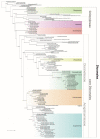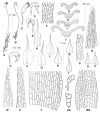New Taxonomic Arrangement of Dicranella s.l. and Aongstroemia s.l. (Dicranidae, Bryophyta)
- PMID: 36987046
- PMCID: PMC10052081
- DOI: 10.3390/plants12061360
New Taxonomic Arrangement of Dicranella s.l. and Aongstroemia s.l. (Dicranidae, Bryophyta)
Abstract
The recent molecular phylogenetic study of the families Aongstroemiaceae and Dicranellaceae, which resolved the genera Aongstroemia and Dicranella as polyphyletic, indicated the need for changes in their circumscription and provided new morphological evidence to support the formal description of newly recognized lineages. Following up on these results, the present study adds another molecular marker, the highly informative trnK-psbA region, to a subset of previously analyzed taxa and presents molecular data from newly analyzed austral representatives of Dicranella and collections of Dicranella-like plants from North Asia. The molecular data are linked with morphological traits, particularly the leaf shape, tuber morphology, and capsule and peristome characters. Based on this multi-proxy evidence, we propose three new families (Dicranellopsidaceae, Rhizogemmaceae, and Ruficaulaceae) and six new genera (Bryopalisotia, Calcidicranella, Dicranellopsis, Protoaongstroemia, Rhizogemma, and Ruficaulis) to accommodate the described species according to the revealed phylogenetic affinities. Additionally, we amend the circumscriptions of the families Aongstroemiaceae and Dicranellaceae, as well as the genera Aongstroemia and Dicranella. In addition to the monotypic Protoaongstroemia that contains the newly described dicranelloid plant with a 2-3-layered distal leaf portion from Pacific Russia, P. sachalinensis, Dicranella thermalis is described for a D. heteromalla-like plant from the same region. Fourteen new combinations, including one new status change, are proposed.
Keywords: Haplolepidous mosses; biodiversity; morphological convergence; nad5 G1 intron; phylogenetics; polyphyly; trnK; trnS-trnF region.
Conflict of interest statement
The authors declare no conflict of interest.
Figures






Similar articles
-
Undiscovered Biodiversity of the European Moss Flora: Neodicranella hamulosa (Aongstroemiaceae), a New Genus and Species from SW Portugal.Plants (Basel). 2021 Oct 25;10(11):2289. doi: 10.3390/plants10112289. Plants (Basel). 2021. PMID: 34834650 Free PMC article.
-
[RPS4 and NAD5 sequences evidenced of polyphyly of ditrichaceae and parallelisms in the evolution of haplolepidous mosses].Mol Biol (Mosk). 2015 Nov-Dec;49(6):993-7. doi: 10.7868/S0026898415060075. Mol Biol (Mosk). 2015. PMID: 26710780 Russian.
-
Need for split: integrative taxonomy reveals unnoticed diversity in the subaquatic species of Pseudohygrohypnum (Pylaisiaceae, Bryophyta).PeerJ. 2022 Apr 26;10:e13260. doi: 10.7717/peerj.13260. eCollection 2022. PeerJ. 2022. PMID: 35497188 Free PMC article.
-
Ectomycorrhizal lifestyle in fungi: global diversity, distribution, and evolution of phylogenetic lineages.Mycorrhiza. 2010 Apr;20(4):217-63. doi: 10.1007/s00572-009-0274-x. Epub 2009 Sep 16. Mycorrhiza. 2010. PMID: 20191371 Review.
-
Revised classification of the New World Cylapini (Heteroptera: Miridae: Cylapinae): taxonomic review of the genera Cylapinus, Cylapoides and Peltidocylapus and a morphology-based phylogenetic analysis of tribe Cylapini.Zootaxa. 2021 Dec 6;5074(1):1-66. doi: 10.11646/zootaxa.5074.1.1. Zootaxa. 2021. PMID: 35390841 Review.
Cited by
-
On the Cryptic Speciation in the Mosses with East Asia-East North America Disjunction: A Case Study of Two Poorly Understood Mosses from the Southern Extremity of the Russian Far East.Plants (Basel). 2024 Dec 20;13(24):3558. doi: 10.3390/plants13243558. Plants (Basel). 2024. PMID: 39771256 Free PMC article.
References
-
- Ignatov M.S., Huttunen S. Brachytheciaceae (Bryophyta)—A family of sibling genera. Arctoa. 2002;11:245–296. doi: 10.15298/arctoa.11.20. - DOI
-
- Vanderpoorten A., Hedenäs L., Cox C.J., Shaw A.J. Circumscription, classification, and (Bryopsida) inferred from nuclear and chloroplast DNA sequence data and morphology taxonomy of Amblystegiaceae. Taxon. 2002;51:115–122. doi: 10.2307/1554968. - DOI
-
- Hedenäs L. Additional insights into the phylogeny of Calliergon, Loeskypnum, Straminergon, and Warnstorfia (Bryophyta: Calliergonaceae) J. Hattori Bot. Lab. 2006;100:125–134.
-
- Olsson S., Buchbender V., Enroth J., Hedenäs L., Huttunen S., Quandt D. Phylogenetic analyses reveal high levels of polyphyly among pleurocarpous lineages as well as novel clades. Bryologist. 2009;112:447–466. doi: 10.1639/0007-2745-112.3.447. - DOI
Grants and funding
LinkOut - more resources
Full Text Sources

